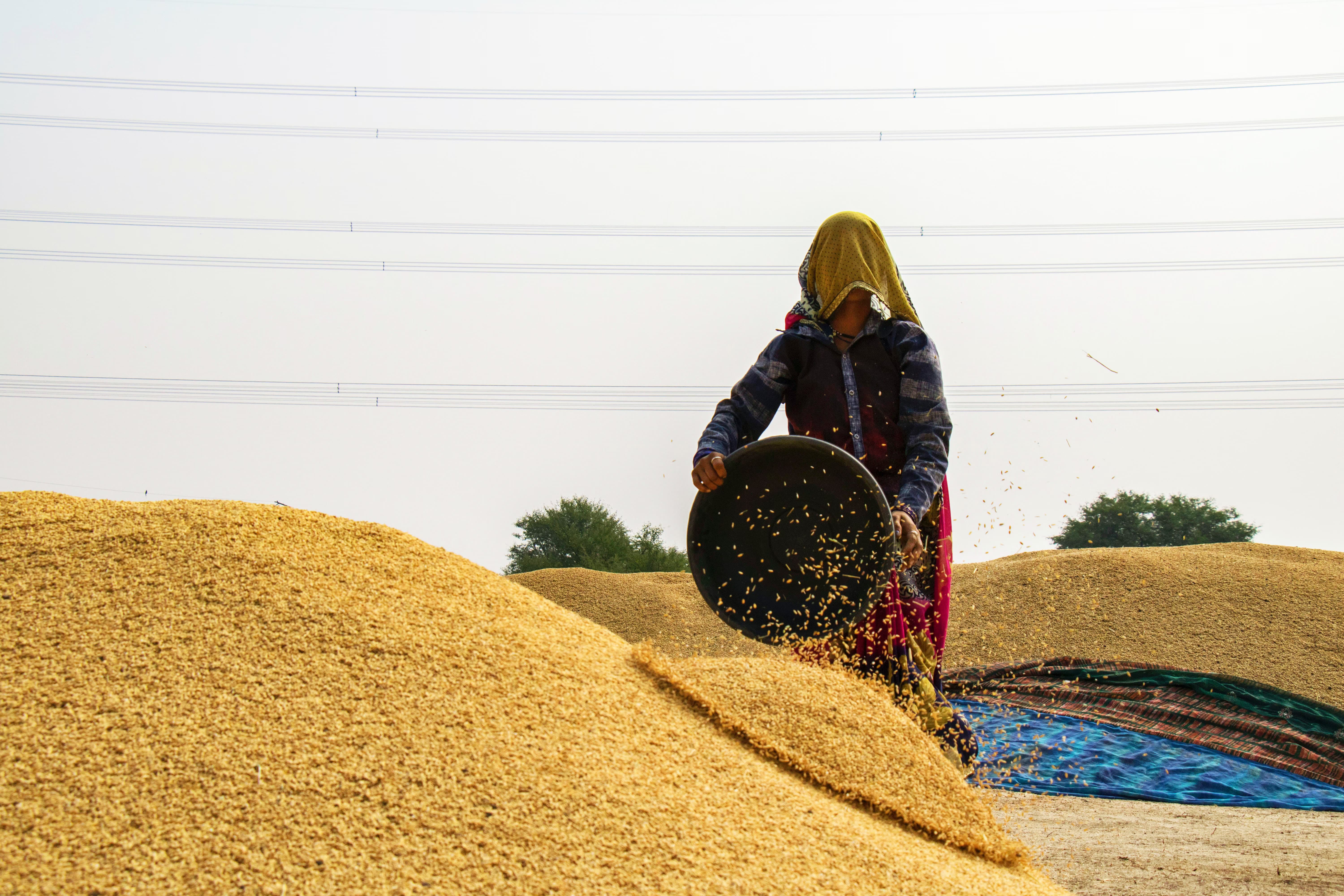First, a sad truth: Actually, no one on this planet should suffer from hunger. Enough food is produced. It is just unfairly distributed. Against this background, the results of the nutrition report published in October 2022 by the "Swiss Alliance for Sustainable Nutrition Worldwide" (Sufosec) seem all the more alarming: since 2015, hunger has been on the rise again. The current multitude of crises further exacerbates these developments. And women are being hit harder.
Since the start of the corona pandemic, the number of people affected by hunger worldwide has risen by 150 million to 828 million. This means that one in ten people is affected by hunger. And of those, around 60 percent are female. A particularly irritating figure given that women are responsible for procuring and preparing food in most countries - and account for 60 percent of the agricultural workforce. In 2020, women were 11 percent more likely than men to suffer from malnutrition or hunger. By 2030, the figure might be as high as 14 percent.
Interesting figures can also be found at the Food and Agriculture Organization of the United Nations (FAO): In the Global South, agricultural yields could be increased by 20 to 30 percent if women had equal access to and usage of land as men. This would increase local food security and reduce the number of hungry people worldwide by around 12 to 17 percent.
One person who knows what lies behind all these figures is Sabine Maier. She is the executive director of the NGO Vivamos Mejor, one of Sufosec's six alliance partners and co-chair of the alliance.
Sabine Maier, women worldwide get less to eat than men. How do you explain that?
Of course, it has to do with the reality that women are still not always treated equally in the household. Studies show that only 20 percent of women own land. Women are more prone to anemia since they do not eat enough and often eat only what is left over after caring for their husbands and children. This is due to systemic and patriarchal factors.
What does this mean? Why is the number of hungry women increasing?
The fact that the proportion of women is increasing more has to do with the fact that gender inequality has increased again in many countries during the crises, among other things. Women are more likely than men to work in an unregulated labor market and to have precarious jobs that are the first to go during a crisis. Women also have less access to capital and are less able to compensate for income gaps. In addition, numerous countries closed schools and childcare for months during the corona pandemic. This also prevented women from earning the income they needed - because they were the ones taking care of the children. All these factors contribute to women suffering more from hunger.
Globally, anemia affects nearly one in every three women between the ages of 15 and 49. That's 571 million women. Are the consequences of malnutrition limited to the Global South?
No. Malnutrition is an issue in so-called developed countries as well, but it manifests itself in a different way. Malnutrition is defined as a lack of a well-balanced diet. This is often also a question of budget and knowledge. So it can be that one has deficiency symptoms such as anemia while being overweight. Malnutrition is particularly tricky during pregnancy. Because it also has an effect on children already being born too light and too small - so that the next generation is also undernourished. In other words, if we improve women's nutrition, we break this vicious circle.
Does this also mean that development cooperation has had little impact in recent decades?
Development cooperation has made significant progress in many areas, which is often forgotten. There are more children and also more girls in school than 20 years ago, more people can write and read. Until 2015, hunger also fell steadily worldwide among women and men. With the crises, there is a disturbing kink in these developments that worries me. But the question is whether these crises would not have hit the poorest people much harder without the development aid that preceded them.
How can we combat the current developments in the field of nutrition?
By systematically strengthening the role of women in society. For example, we have projects in the highlands of Guatemala that strengthen indigenous women's self-confidence and help them improve their position in small steps. So that they dare to take their share of a meal. We can also fundamentally reduce hunger and poverty by strengthening local food systems and making them more crisis-resistant, for example through agroecological production. A large part of food is still produced by small farmers. But in the global South, there are no agricultural doctrines like there are here; descendants therefore often repeat harmful farming methods such as slash-and-burn or monoculture cultivation.
Why?
Their level of education is low, and they fall for the marketing promises of industrial seed and fertilizer sellers. In addition, there are new challenges such as lack of rain, floods, and loss of fertile soil. As a result, crop yields continue to decline. Much can be done about this: by educating people and working with them to create more resistant cropping systems, skillfully combining products, preserving soil fertility, and reducing external, expensive purchases.
Since 2015, hunger has been on the rise again, having previously fallen steadily. Why?
It is related to the accumulation of crises and the vulnerability of the current global food system. Our current globalized distribution system is too vulnerable to supply chain bottlenecks and price shocks. In recent years, we have had several significant catastrophes in quick succession: Covid, the Ukraine war, climate change. With the latter, production conditions are rapidly changing: rain patterns are shifting, extreme weather events are becoming more often, new pests are emerging. These, in my opinion, are symptoms of the problem, but the root cause is a lack of investment in local food systems and organic, smallholder agriculture.
You mentioned the topic of water. What are the challenges here?
Water is already one of the major conflict issues on the planet. An example from Central America: The big challenge there is not so much that the annual amount of water is decreasing. The problem is the distribution: In a short period of time, far too much water arrives, then again the rain fails for months, springs dry up, conflicts arise. In order to have water during the longer dry periods, the protection of forest areas is extremely important. Forests act like sponges, they store water and slowly release it to groundwater. When forests disappear, this function is lost and the whole microclimate changes. Unfortunately, these forests are under threat, because of the outdated cultivation methods used by small farmers. When people harvest less from their existing fields, they burn forest for new cropland. In this way, they set in motion a vicious cycle.
Aren't women also mainly responsible for fetching water?
They are. When there is less water, women have to put more time and effort into fetching water. They lack this time and energy for productive work. Water security is therefore not only central to women's quality of life, but also to their economic development.
You have been involved in development cooperation for nearly two decades. What developments have you observed during this time?
I find the present debate in this country about putting more money into the military and less into development cooperation frightening. Yet we know that wars are fostered by widespread and prevailing inequality. It is often about unequal access to land, water, and income. However, I see a number of positive developments: Our nutrition report provides scientific evidence that families have been able to improve their food security impressively thanks to agroecology. That motivates me.
Despite the numerous crises, are you still optimistic about the future?
Yes, because hunger is man-made and we can end it. We can change where our investments are going, we know the necessary approaches and solutions. However, seeing who makes decisions in this world - returning to the topic of men and women - makes me pessimistic at times. Still too often, it's white, old men. We need to achieve more diversity among decision-makers in order to find smarter, more sustainable solutions to our global challenges.
And what can I do as an individual to fight global hunger?
Anything that accelerates climate change exacerbates the problem of hunger. We can therefore reduce our ecological footprint, buy local, seasonal and fair whenever possible. And pay attention to how our money works: Is my money invested sustainably, or is my bank still investing in climate-damaging companies? Does my pension fund rely on sustainable investments? Money is a big lever, and even the mass of small amounts can make a big difference.



